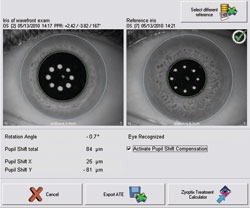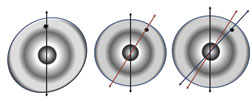Dynamic intraoperative rotational eye tracking improves results of LASIK in cases with astigmatism
 Amar Agarwal |
Cyclotorsional misalignment between the LASIK ablation pattern and the eye can result in postoperative residual undercorrection. To counter this, iris recognition-based alignment of the ablation beam to the cornea has been incorporated in many laser platforms. Most of the recent laser platforms with iris recognition have a facility for pre-ablation iris recognition.
Dynamic intraoperative rotational eye tracking
Iris recognition helps to correct the cyclotorsional misalignment between eyes with dilated and undilated pupils (Figure 1) and between the eye in the sitting position (during refractive error and higher-order aberration assessment) and the eye in the supine position (during actual delivery of the treatment). However, the rotational activity of the eye continues throughout the ablation and therefore can lead to a dynamic misalignment between the laser and the ablation bed (Figure 2). Therefore, an intra-ablation dynamic cyclorotational activity tracker is the ideal requirement.
 Figure 1. Iris registration being performed to compare misalignment (translational and cyclotorsional) between the iris image at smaller pupil size and the wavefront acquisition pupil size. |
 Figure 2. Diagram explaining process of dynamic misalignment. The black mark represents a nevus or a landmark on the iris, used to illustrate the concept of cyclotorsional misalignment. Left: pre-ablation reference image. Middle: pre-ablation static iris recognition; note that the angle between the black and brown lines is the static cyclotorsional degree. Right: an intraoperative situation in which the eye has rotated and the current amount of cyclotorsion (angle between the black and green lines) is different from that noted at the start of the ablation (angle between the black and brown lines). Images: Agarwal A |
The Technolas 217z100 with advanced control eye tracker with dynamic rotational eye tracking (Technolas Perfect Vision) is a new laser platform with dynamic intra-ablation tracking. This platform has software that allows for intraoperative dynamic cyclorotational activity correction, in addition to static pre-ablation rotational misalignment assessment. Dynamic rotational tracking and compensation occur independent of x-y-z tracking. The user interface displays the “live” cyclotorsional value as a line graph, with degrees of cyclorotation on the y axis and the amount of treatment on the x axis. The treatment output printouts consist of mean intraoperative cyclotorsional misalignment and the range of intraoperative cyclotorsion in addition to the other values.
Study results
Neuhann and colleagues had shown the efficacy of the rotational tracker in experimental conditions and backed it with good results of LASIK with intraoperative dynamic tracking in a noncomparative study. In another study, we saw that mathematical benefits of incorporating a dynamic-tracking and tissue-saving algorithm were high, and that 29 of 101 eyes (28.7%) with astigmatism in the study cohort would have had more than 10% of the initial astigmatism left after treatment if iris recognition and dynamic rotational eye tracking were not used.
We have also evaluated the predictive factors for successful performance of dynamic rotational eye tracking. We concluded that intraoperative cyclotorsional activity depends on the age, gender and duration of ablation (pulses delivered). Femtosecond flaps had a higher incidence of new image linkage intraoperatively; however, they did not have a disadvantage over microkeratome flaps in terms of iris recognition and successful completion of image-linked intraoperative dynamic rotational tracking. The protocol for use of intraoperative tracking and flowcharts to get good outcomes was also explained in this paper.
Tracking in high astigmatism
It remained to be seen how this new technology would fare with high astigmatism and in a comparative fashion. Therefore, we did a randomized controlled trial to compare the outcomes of LASIK without iris recognition, with iris recognition and with iris recognition with dynamic intraoperative tracking in cases with astigmatism more than 1 D. The preoperative mean refractive error and the magnitude of cylinder were comparable in the three groups. The mean postoperative refractive error and cylindrical values were significantly lower in the cases that underwent iris recognition and dynamic tracking. On Alpins analysis, target and surgically induced astigmatism were comparable among the three groups; however, difference vector, error angle, correction index, success index and flattening index were best in the iris recognition and dynamic tracking group.
In a previous study comparing iris recognition with no iris recognition, Moshirfar and colleagues found no differences in the two outcomes. They noted lack of continuous intraoperative cyclotorsional monitoring as one of the possible reasons for no difference in the outcomes of iris recognition and non-iris recognition groups. As suggested by them, pre-ablation iris registration may not have been sufficient to counter intraoperative activity. This also provides evidence for the possible benefits of intraoperative cyclotorsional tracking and correction.
|
|
Theoretically, the effect of iris registration should be beneficial in cases with higher values of centroid shift, even with pure spherical errors or with high-order aberrations (Figure 3). A future study to evaluate the effect of iris recognition in treatment of defocus errors and high-order aberrations may shed more information.
Conclusion
The current evidence in the literature suggests that dynamic rotational eye tracking is a beneficial new addition to the LASIK platform and has better results in cases with myopia with astigmatism of 1 D or greater.
References:
- Bausch & Lomb, Inc. Specifications Technolas 217z100 excimer laser. In: Bausch & Lomb Zyoptix Technolas 217z100 Laser Systems Operator’s manual, version 5.1. Rochester, NY: Bausch & Lomb, Inc.; 2008;19-1.
- Ciccio AE, Durrie DS, Stahl JE, Schwendeman F. Ocular cyclotorsion during customized laser ablation. J Refract Surg. 2005;21(6):S772-S774.
- Hori-Komai Y, Sakai C, Toda I, Ito M, Yamamoto T, Tsubota K. Detection of cyclotorsional rotation during excimer laser ablation in LASIK. J Refract Surg. 2007;23(9):911-915.
- Kermani O. Alignment in customized laser in situ keratomileusis. J Refract Surg. 2004;20(5 Suppl):S651-S658.
- Kim H, Joo CK. Ocular cyclotorsion according to body position and flap creation before laser in situ keratomileusis. J Cataract Refract Surg. 2008;34(4):557-561.
- Moshirfar M, Chen MC, Espandar L, et al. Effect of iris registration on outcomes of LASIK for myopia with the VISX CustomVue platform. J Refract Surg. 2009;25(6):493-502.
- Neuhann M, Lege B, Bauer M, et al. Static and dynamic rotational eye tracking during LASIK treatment of myopic astigmatism with the Zyoptix laser platform and advanced control eye tracker. J Refract Surg. 2010;26(1):17-27.
- Prakash G, Agarwal A, Kumar DA, et al. Surface ablation with iris recognition and dynamic rotational eye tracking-based tissue saving treatment with the Technolas 217z excimer laser [published online ahead of print May 19, 2010]. J Refract Surg. doi:10.3928/1081597X-20100428-01.
- Prakash G, Ashok Kumar D, Agarwal A, et al. A randomized comparative trial to compare LASIK for myopic astigmatism without iris recognition, with iris recognition and with iris recognition assisted dynamic rotational eye tracking. J Cataract Refract Surg. In press.
- Prakash G, Ashok Kumar D, Agarwal A, et al. Predictive factor analysis for successful performance of iris recognition-assisted dynamic rotational eye tracking during laser in situ keratomileusis. Am J Ophthalmol. 2010;149(2):229-237.
- Swami AU, Steinert RF, Osborne WE, White AA. Rotational malposition during laser in situ keratomileusis. Am J Ophthalmol. 2002;133(4):561-562.
- Amar Agarwal, MS, FRCS, FRCOphth, is director of Dr. Agarwal’s Eye Hospital and Eye Research Centre. Prof. Agarwal is the author of several books published by SLACK Incorporated, publisher of Ocular Surgery News, including Phaco Nightmares: Conquering Cataract Catastrophes, Bimanual Phaco: Mastering the Phakonit/MICS Technique, Dry Eye: A Practical Guide to Ocular Surface Disorders and Stem Cell Surgery and Presbyopia: A Surgical Textbook. He can be reached at 19 Cathedral Road, Chennai 600 086, India; fax: 91-44-28115871; e-mail: dragarwal@vsnl.com; website: www.dragarwal.com.
- Disclosures: Dr. Prakash and Dr. Kumar have no direct financial interest in any of the products mentioned in this article, nor are they consultants for any companies mentioned. Dr. Agarwal is a consultant to Bausch + Lomb.


